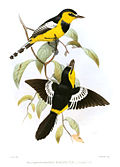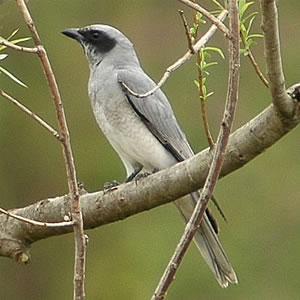
The cuckooshrikes and allies in the family Campephagidae are small to medium-sized passerine bird species found in the subtropical and tropical Africa, Asia and Australasia. The 93 species are divided into 11 genera. The woodshrikes (Tephrodornis) were often considered to be in this family but are now placed in their own family, Vangidae, along with the philentomas and the flycatcher-shrikes. Another genus, Chlamydochaera, which has one species, the black-breasted fruithunter, was often placed in this family but has now been shown to be a thrush (Turdidae).
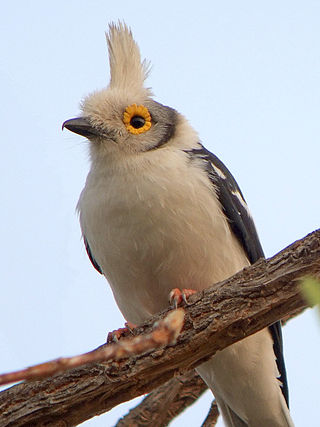
Helmetshrikes are a family uniting some smallish to mid-sized songbird species. They were included with the true shrikes in the family Laniidae, later on split between several presumably closely related groups such as bushshrikes (Malaconotidae) and cuckooshrikes (Campephagidae), but are now considered sufficiently distinctive to be separated from that group into the family Vangidae.
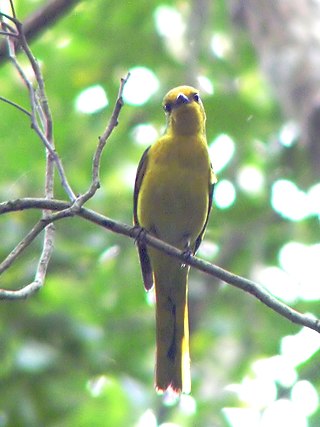
The minivets are passerine birds belonging to the genus Pericrocotus in the cuckooshrike family Campephagidae. There are about 15 species, occurring mainly in forests in southern and eastern Asia. They are fairly small, slender birds with long tails and an erect posture. Many species have bright red or yellow markings. They feed mainly on insects, foraging in groups in the tree canopy.

Campephaga is a genus of bird in the cuckoo-shrike family Campephagidae.

The western wattled cuckooshrike or Ghana cuckooshrike is a species of bird in the family Campephagidae. It is found in Ivory Coast, Ghana, Guinea, Liberia, and Sierra Leone. Its natural habitats are subtropical or tropical moist lowland forest and subtropical or tropical swamps. It is threatened by habitat loss.

The eastern wattled cuckooshrike or oriole cuckooshrike is a species of bird in the family Campephagidae. It is found in Cameroon, Central African Republic, Republic of the Congo, Democratic Republic of the Congo, Gabon, and Nigeria. Its natural habitat is subtropical or tropical moist lowland forest.
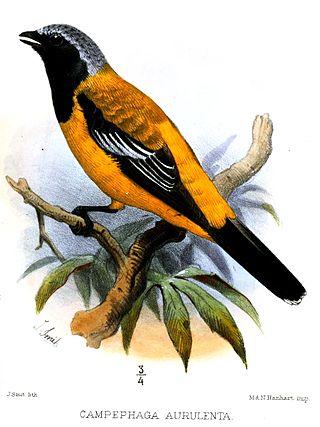
The golden cuckooshrike is a species of bird in the family Campephagidae. It is monotypic within the genus Campochaera. It is found in New Guinea. Its natural habitat is subtropical or tropical moist lowland forests.

The pygmy cuckooshrike is a species of bird in the cuckooshrike family Campephagidae. It is endemic to the Indonesian island of Sulawesi. Its natural habitat is subtropical or tropical moist montane forests.
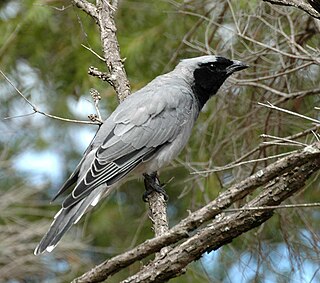
Coracina is a large genus of birds in the cuckooshrike family Campephagidae.

The New Caledonian cuckooshrike or New Caledonian cicadabird is a species of bird in the family Campephagidae. It is endemic to New Caledonia. Some taxonomists place this species in the genus Analisoma.

The blue cuckooshrike is a species of bird in the Cuckooshrike family, Campephagidae. It is widespread across the African tropical rainforest, from Sierra Leone and Liberia to eastern and south-western Democratic Republic of Congo. Its natural habitats are subtropical or tropical dry forests and subtropical or tropical moist lowland forests.

The grey cuckooshrike is a species of bird in the cuckooshrike family Campephagidae. It is a medium-sized forest bird, with grey to blue-grey plumage and large black eyes. There are two subspecies that occur in forest patches of southern and central Africa respectively.
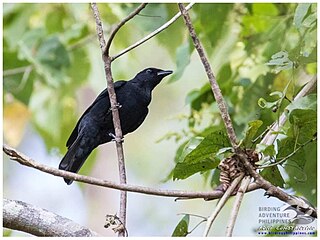
The blackish cuckooshrike or the blackish cicadabird or Luzon graybird, is a species of bird in the family Campephagidae. It is endemic to the Philippines on the islands of Luzon, Catanduanes, Marinduque and Cebu where it is presumed extinct. Some taxonomists place this species in the genus Analisoma.Its natural habitat is tropical moist lowland forest where it is believed to be declining due to habitat loss.

McGregor's cuckooshrike or the sharp-tailed cuckooshrike, is a species of bird in the family Campephagidae. It is endemic to Mindanao island on the Philippines. Its natural habitat is tropical moist montane forest. It is declining due to habitat loss.
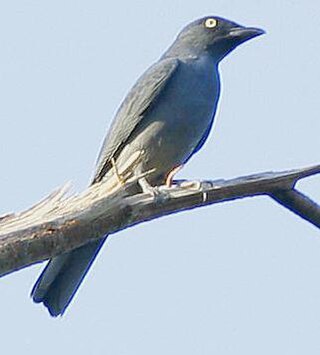
The bar-bellied cuckooshrike is a species of bird in the family Campephagidae. It is found in Thailand, Malaysia, Indonesia, and the Philippines, and its natural habitats include mangrove forest, dry forest, swamp forest, and secondary forest. The plumage varies among the subspecies, with different amounts of barring on the underparts. The International Union for Conservation of Nature (IUCN) has assessed the species as one of least-concern.

A caruncle is defined as 'a small, fleshy excrescence that is a normal part of an animal's anatomy'. Within this definition, caruncles in birds include wattles, combs, snoods, and earlobes. The term caruncle is derived from Latin caruncula, the diminutive of carō, "flesh".

Lalage is a genus of passerine birds belonging to the cuckooshrike family Campephagidae, many of which are commonly known as trillers. There are about 18 species which occur in southern Asia and Australasia with a number of species on Pacific islands. They feed mainly on insects and fruit. They build a neat cup-shaped nest high in a tree.

Edolisoma is a genus of birds in the cuckooshrike family Campephagidae that are native to the Central Indo-Pacific region, Australia and New Guinea.

Analisoma is a genus of bird in the family Campephagidae recognized in some taxonomies. Many taxonomists consider this genus conspecific with the genus Edolisoma. It contains the following species:

Ceblepyris is a genus of African passerine birds in the cuckooshrike family Campephagidae.























